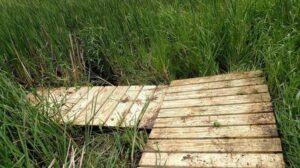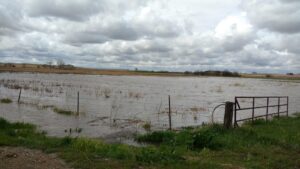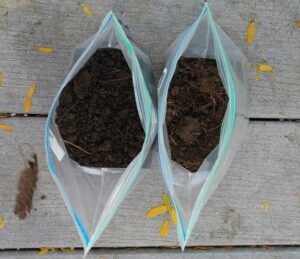Final Report for FNC15-1012
Project Information
- Project Duration: March 2015 – January 2017
- Date of Report: January 31, 2017
PROJECT BACKGROUND
Darby Springs farm raises pastured dairy cattle, laying hens, and broiler chickens. When the project began we were grazing 7 acres of upland pasture with 3 dairy cows, 300 seasonal broilers, and 50 laying hens. It is owned and operated by William and Crystal Powers. We use holistic grazing to plan out the daily rotations.
PROJECT DESCRIPTION
GOAL:
The goal of our project is to examine the economic and environmental viability of grazing wetland acres.
PROCESS
We had two main aspects to the project: 1) Wetland grazing, 2) Using walkways to cross wetland areas.
Wetland grazing
We wanted to determine if the sedge meadows and cattails of our wetlands could be grazed while maintaining cattle productivity and while improving the wetland area. We needed to learn:
- How far into the cattails we would be able to get the cattle without the cattle getting stuck
- How much of the sedges, reed canary grass, and cattails could the cattle eat without losing productivity
- Would the ground get too mucked up, hindering regrowth
- How would the grazing impact the water & soil quality, plant species, and insects.
We were conservative in our grazing plan, with the goal of 45+ days of regrowth before grazing any location for a second time. To be able to see differences we set up some different areas: no grazing, single short duration (4-8hrs) graze (some early season, some late), two short duration grazes (45 day recovery between), and a 1 week continuous graze. We started out with each wetland paddock containing enough dry area that all the cattle could lay on a dry spot. Initially the wetland acres were alternated with upland paddocks, later we tried several days of continuous sedge meadow at different times in the season to see if they could maintain on those paddocks.
We waited to start grazing until the grasses were approximately 6” tall. The goal was to graze approximately 30% of the available forage with 12 hour moves. As we moved into summer, we found that the cattle preferred the wetland acres in the hotter times of the day, so during our second grazing, the cattle were given a wetland only paddock for 4-6 hrs. On the hottest days (above 90 degrees), the cattle were moved to a paddock with shade from approximately noon until 7pm.
The cattle were initially allowed to decide how far into the wetlands they wanted to graze. After we had to pull a cow out of the mud, we were more restrictive in some of the paddocks.
We used polywire with step in posts throughout the grazing area. Initially we thought we would need a mower to keep the polywire clear in the wetland areas, but found that just like any grazing, it kept the plants short enough that a mower was not needed.
Wetland Crossings

The wetland crossings were used to access acres of our property that otherwise would not be available for grazing. Because the water is never more than a couple inches deep, we opted to put the crossing panels directly onto the soil rather than have the expense of some form of pilings. In a couple spots of deeper water we used concrete block to elevate the panels more. To make it comfortable for the cattle to cross there were only small gaps in the boards and they were 3’ wide x 6’ long. These ended up weighing about 150 lbs each. We chose to use treated lumber since it would be in contact with wet soil most of the year. They were place at the narrowest portions of the wetlands.
After building and installing the first sections, we had several big floods in our valley. This did not affect the western walkway, however the southern walkway is closer to the main channel which results in water about 7’ deep. Several of the sections were pulled through the culvert and carried downstream. We were able to recover all but one section. We decided to try using cable to anchor them to some concrete block and see if that will hold. This raised the cost of building these sections and we determined that it was not feasible to build the longest stretch through the north and keep it anchored in place.

PEOPLE
William Powers managed the livestock and grazing day to day.
Crystal Powers did the plant assessments, monitoring, and testing as well as outreach on the project.
Glenn Melvin helped build the wetland crossings.
RESULTS
Grazing
Forage value: We were pleased with the plants in the wetland areas. We gazed a total of 35 AUM on 9 acres the first year and 40 AUM the second, which compares favorably with typical productivity on upland pastures of our region. All classes of cows (lactating, dry, heifers) gained body condition throughout the spring and maintained it throughout the grazing season. Sedges, reed canary grass, and cattails provided quality forage and regrew quickly providing larger quantities of forage then our upland pastures.
Cow comfort: We found that the cattle preferred to be in the wetlands during the heat of the day. Based on our observations this was because the water cooled their feet and legs and the taller wetland plants brushed off the flies, reducing the fly load by nearly half.
Logistics: we found that we could keep the fences hot without mowing pathways, so we have not yet purchased a mower. Setting up fence takes longer; about twice as long with the more challenging footing.

Ecosystems
Plant species: In the grazed areas the cattle grazed off all the plants evenly; this gave preference to the perennial sedges and grasses. The cattails did not regrow as quickly as the sedges so we saw a move toward more sedge meadow of about 10’ in the grazed areas. The same held true in year 2 with a couple new wildflower species appearing and larger quantities of wildflowers along the edges of the paddocks. In the areas only grazed once, it did allow more late season annuals like swamp milkweed and sunflower to grow.

USDA Pasture Scoring (across two seasons)
|
Sedge Meadow: 26”-28” |
Cattails: 7’ & 20” understory |
||||
|
Many ladybugs & mayflies |
|||||
|
|
# of species Non/graze |
% of cover non/graze |
|
# of species Non/graze |
% of cover Non/graze |
|
Forbs |
8/10 |
10/15 |
Forbs |
2/6 |
5/10 |
|
Sedges |
3 |
40/35 |
Sedges |
2/3 |
5/20 |
|
Grass |
2/3 |
20/25 |
Grass |
2 |
5/10 |
|
Cattail |
1 |
10/5 |
Cattail |
2 |
40/30 |
|
open |
|
20 |
open |
|
45/30 |
|
Pasture score |
Pasture score |
||||
|
|
Non-grazed |
Grazed yr1/yr2 |
|
Non-grazed |
Grazed |
|
Population |
2 |
2/2.5 |
Population |
2 |
2 |
|
Diversity |
4 |
2/2.5 |
Diversity |
4 |
2 |
|
Density |
0 |
0 |
Density |
0 |
0 |
|
Vigor |
2 |
2 |
Vigor |
2 |
0 |
|
Legumes |
0 |
0 |
Legumes |
0 |
0 |
|
Severity of Use |
0 |
4 |
Severity of Use |
0 |
4 |
|
Uniformity of Use |
Na |
4 |
Uniformity of Use |
Na |
4 |
|
Residue |
4 |
4 |
Residue |
0 |
4 |
|
Erosion |
4 |
4 |
Erosion |
4 |
4 |
|
Total |
16 |
23 |
Total |
12 |
20 |
Soil impact: We have two types of wetlands: spring fed (perennially wet), low lying (seasonally wet). In the seasonal wetlands, the second grazing occurs when the soils have dried so it reduces the hoof impact. In the perennial wetlands it will be important to see next year if there are negatives from the more heavily impacted soils. What we did see was that in the wet soils the cattle have a harder time moving their feet, so they do not take as many steps and did not go back over an already grazed area, minimizing the number of hoof pugs in a paddock. We tested some of our grazed and non-grazed soils and found only small differences in carbon and nutrient levels (but even the non-grazed areas were high in all categories). Although visually the grazed soil was darker and had better soil structure. Our main limiting factor is pH (6.6), so we plan to add some lime this winter.

Water: We tested the water at the beginning of the season before the cattle were out to graze and then again at the end of the season after the cattle hand been grazing. There were no differences in the water quality. At both times the wetlands discharged very high quality water (other than a moderately high salt content because of our unique groundwater source).
Insects: In the second year we saw many more butterflies than in the first season.
DISCUSSION
We have found that grazing wetlands are a valuable tool for our operation. We would recommend grazing the edges of wet meadows and down into wetlands to other farmers to improve the value of these acres. We were able to access and use acres that we thought unproductive, while improving plant and wildlife diversity and without negative impact on water quality. We found that by starting grazing early in the season, no more labor was required to manage the cattle in wetland areas than we needed in regular pasture rotations. One negative is the concern of having cattle get caught in the mud, so cattle should be monitored to ensure they are not having trouble in the mud and if so that they are quickly removed. Also care needs to be taken that cattle have areas to escape should the wetland acres flood. Flooding is still a normal part of these ecosystems. Putting in wetland crossings have the advantage of allowing access to new grazing areas. Beef producers likely would not need a built crossing, however dairy producers who need cattle to frequently cross wet areas can find them valuable as long as there are enough new acres to justify the expense of installing the crossing. A disadvantage we found was that in some flooded acres the crossings are not viable because the water can carry away the crossing materials. Overall both practices can give farmers opportunities to improve their land and better utilize marginal acres.

PROJECT IMPACTS
Grazing Wetland Plants
Economics
- Labor: We found the wetland acres had the same labor requirement as our pasture acres.
- Forage: We were able to add 4 weeks grazing on the same number of acres. For a savings of $30/head.
Environmental Impacts
- Improved the diversity of the plants and insects
- Built soil structure
- Had no negative impacts on surface water quality
Wetland Crossing Economics:
- Assume $40/ac (avg low quality cash rent in Eastern NE)
- Allowed us to access 9 additional acres (doubles our available acres)
- Cost to build (inc labor) ~ $7/linear ft
- Return on investment ~ 5 years
- Life of boardwalk ~ 20 years
This cost/ benefit is dependent on how many acres the crossing allows access to and the length needed to access.
OUTREACH
Public Education Field Days (partner with Nebraska Sustainable Agriculture Society).
September 2015: we hosted a “Farmers Night Out!” which was a farm tour highlighting our sustainable agriculture methods, including pasture walks with the low-impact crossings and hands-on discussion of our wetlands grazing results. We had 18 attendees.
2016: We hosted 3 small farmers tours where we highlighted our SARE project. 15 attendees.
Nebraska Sustainable Agriculture Society Conference
2016: Nebraska City, NE, 225 attendees overall, 12 at our breakout session, mostly farmers. Grazing & Ecosystem results were presented by Crystal Powers. Handouts on grazing wetlands methods and lessons learned.
2017: Columbus, NE. 200 attendees overall. Session on Carbon Farming for Soil Health which included data from our grazing project, 35 attendees. And discussed SARE grants as part of a session on Investing in Farms, 10 attendees.
Website: Our project has its own page on our website. In 2015, our overall website had 1563 views by 483 visitors, in 2016 1287 page views, 485 visitors.
Social Media: We used Twitter (410 followers) and Facebook (778 followers) to share pictures and highlights from our project throughout the project.
Articles: We have submitted a summary to the Nebraska Sustainable Agriculture Society Newsletter.
Farm and wetland scavenger hunt: we have only had a couple families out, but plan to continue using into the future.
- Use holistic managment to graze our combined wetland and pasturelands
- Install low-impact wetland crossings
- Monitor plant and wildlife changes over two growing seasons
- Host a public education day
- Present our results at the Nebraska Sustainable Agriculture Society Conference
- Write an article and pamphlet with our results
Environmental benefits:
Plant & wildlife populations:
A spring and fall plant and wildlife survey will be led by Crystal P. with the help of Nebraska Master Naturalists to record the types of species and the amount within each species in both the grazed and un-grazed areas.
- As a control, grazing exclusion areas (1 square yard) will be set up in two zones: wet meadow and shallow wetland, so changes between grazed and non-grazed areas can be compared for plant and insect species differences via survey & monthly photo monitoring.
- Adjacent to the exclusion areas a 1 square yard grazed area will be used for the survey data.
- Bird monitoring will be a 30 min count of all birds seen and heard from the survey location.
- The primary invasive species, cattails & reed canary grass, will be mapped with GPS on the entire property in May and again in September to determine if their extent is reduced.
All visitors to the farm will be encouraged through a brochure & webpage to record wildlife they see and either leave it with us or post it online. Also we will encourage participation in eBird, an online citizen science project of the Cornell Lab of Ornthology, where they list the number and species they see while on the farm. This will provide education to the visitors about our project, help them observe first-hand the impacts, and provide us with some qualitative data on the plants and wildlife.
Water quality:
Samples will be taken from the wetland outlet before and after grazing (May and September) and evaluated for turbidity and fecal coliforms to determine if there are any negative impacts.
The wetland crossings will be monitored with weekly photos to document that they are keeping the livestock walkways free of mud.
Economic benefits:
Income: Cow-days of forage (the amount of time and number of cattle grazed) will be recorded. Forage samples taken prior to grazing using 3, 1 square foot clippings aggregated. These will be tested weekly using a refractometer for brix to determine energy content. Monthly the samples will dried and weighed to determine quantity of available forage, and sent to a lab for basic forage analysis. We will use UNL information to determine the
Expenses: Additional labor required to move cattle in wetlands combined with expenses making and installing the boardwalks divided by the expected life of the boardwalks.
Social benefits:
To measure how many people we reached with the knowledge from our project we will record:
- Number of attendees at the Public Education Day and NSAS conference presentation.
- Number of hits on social media and website.